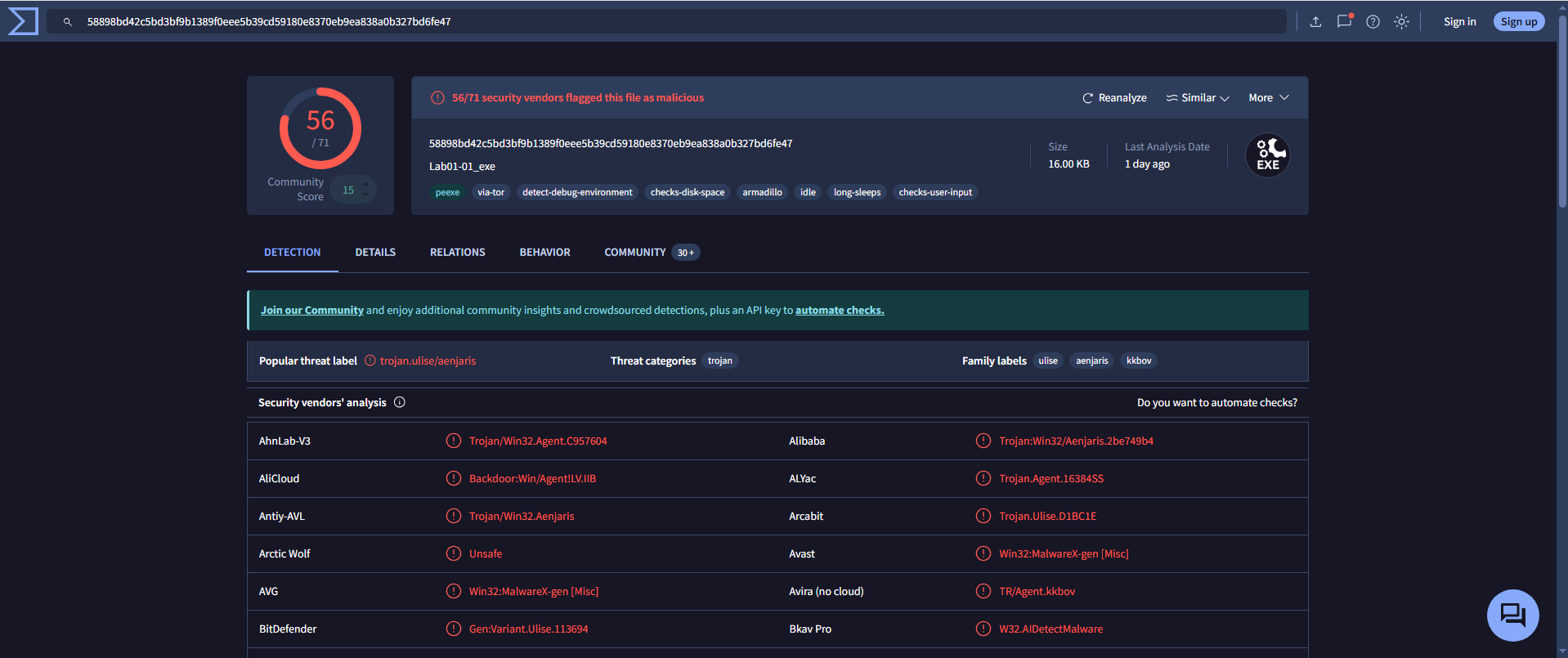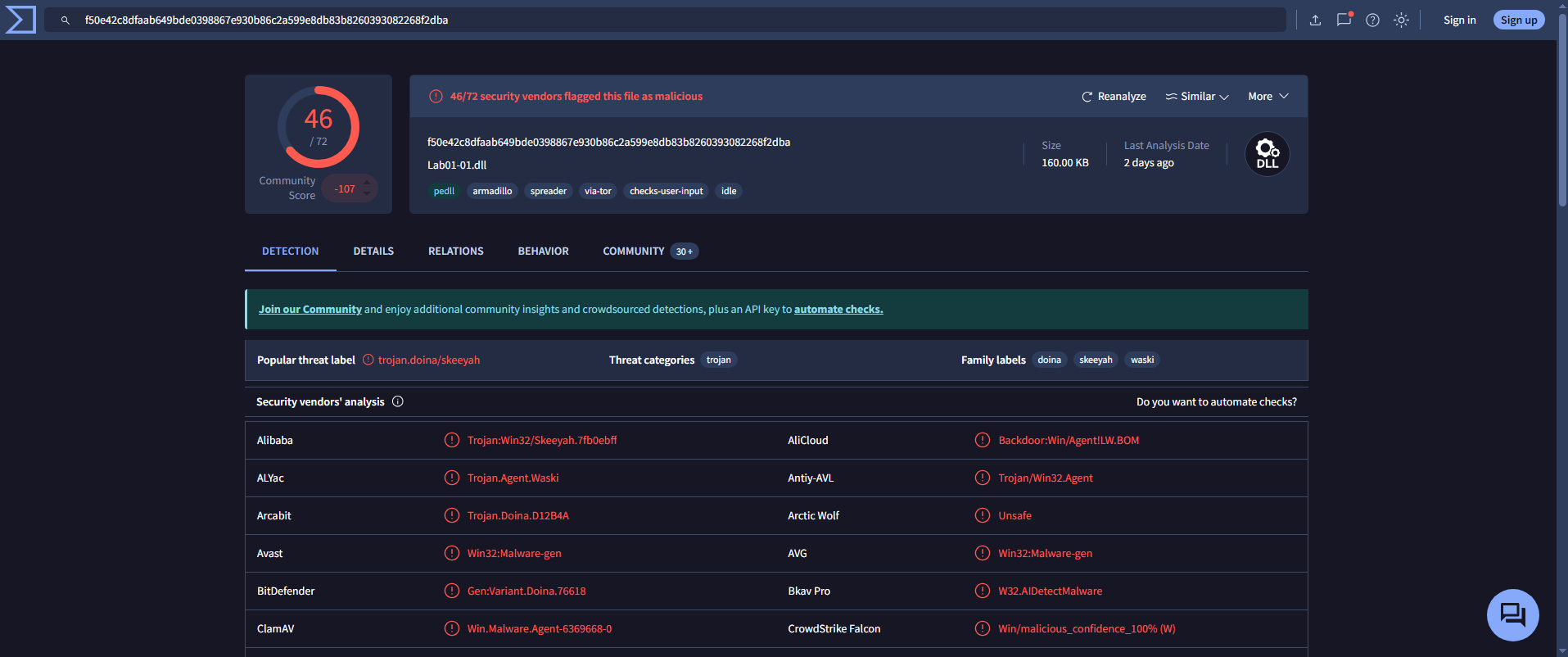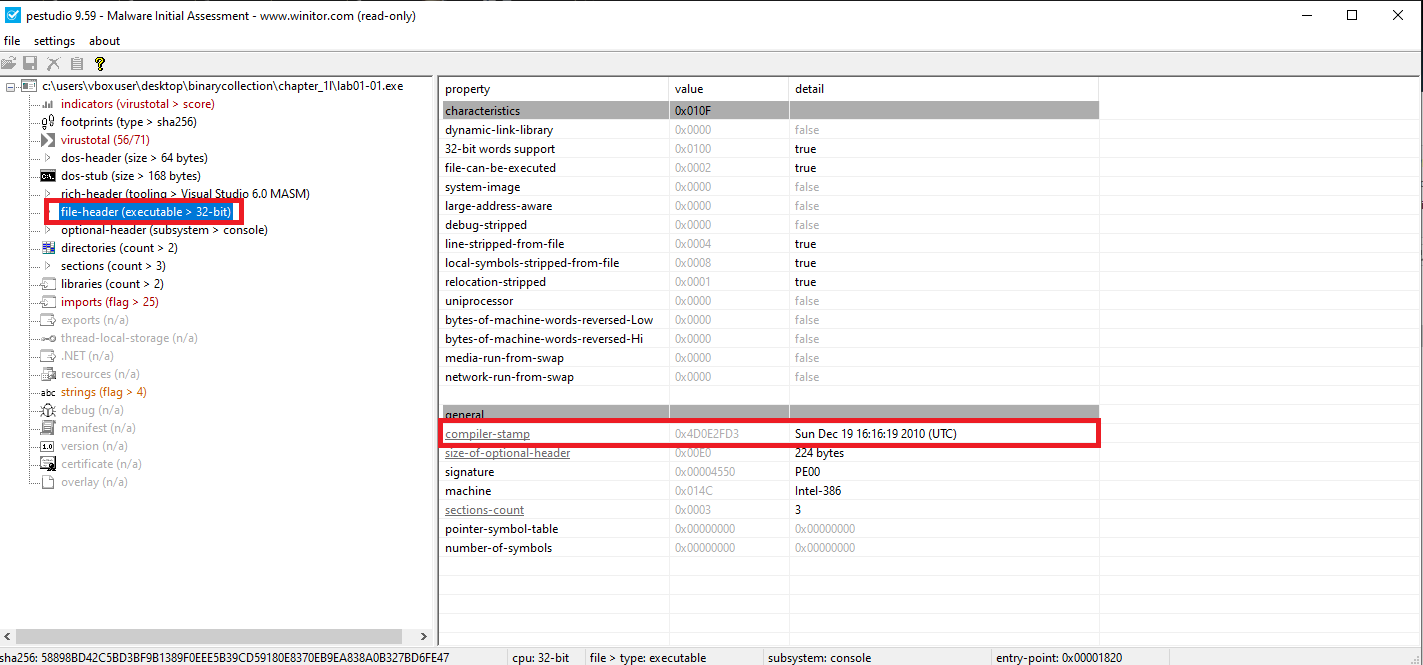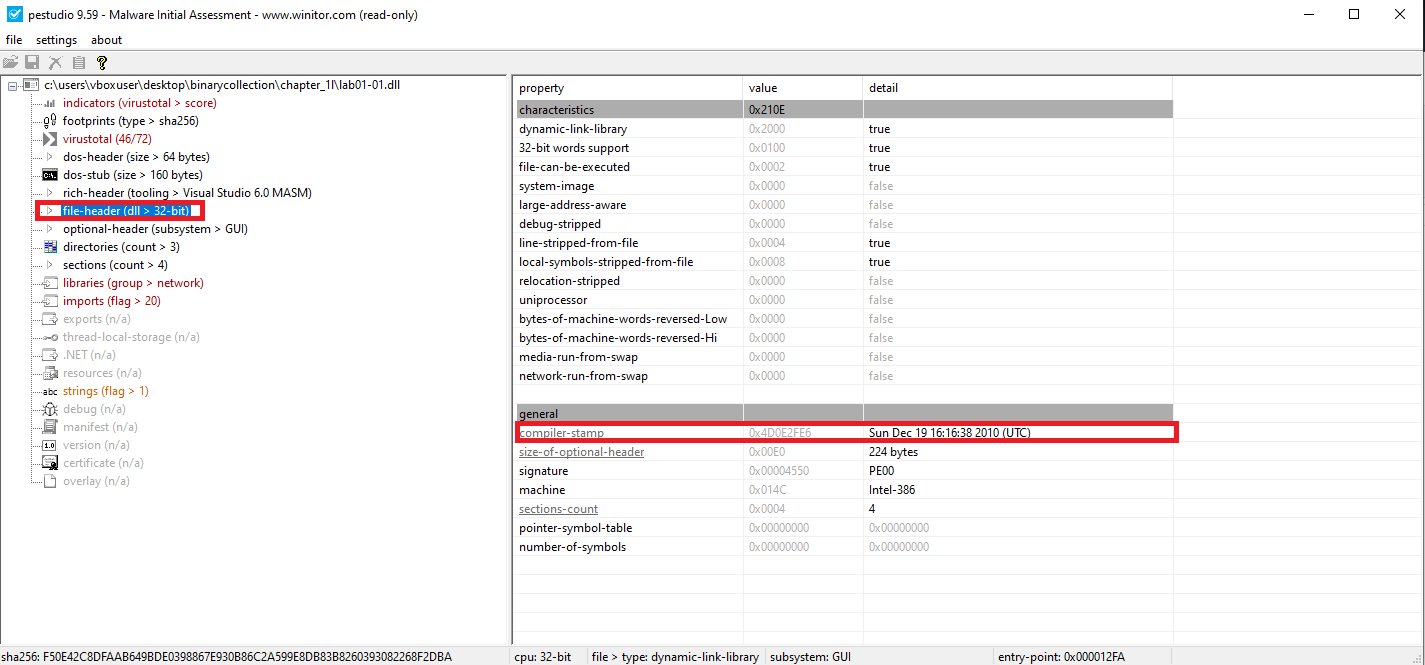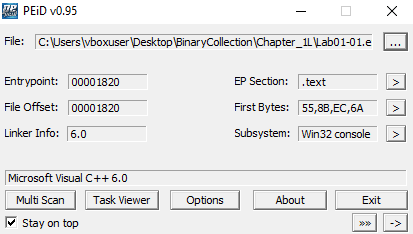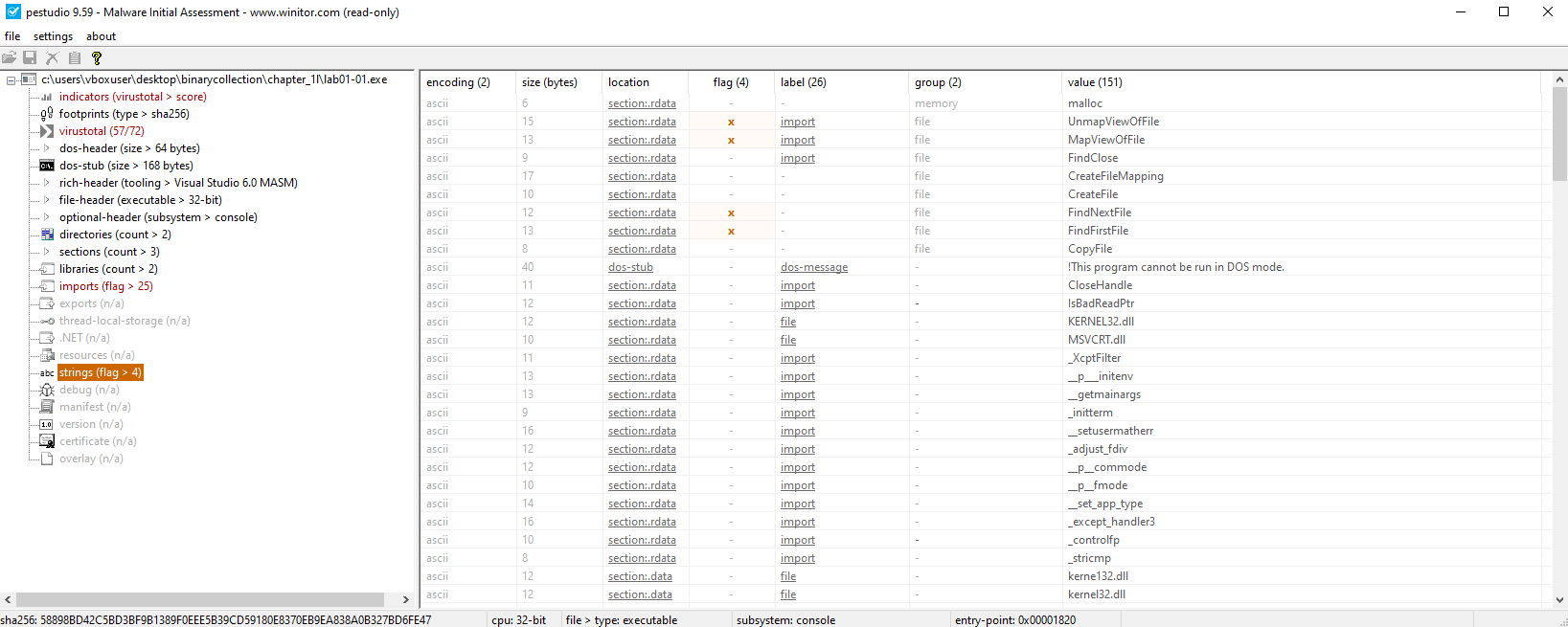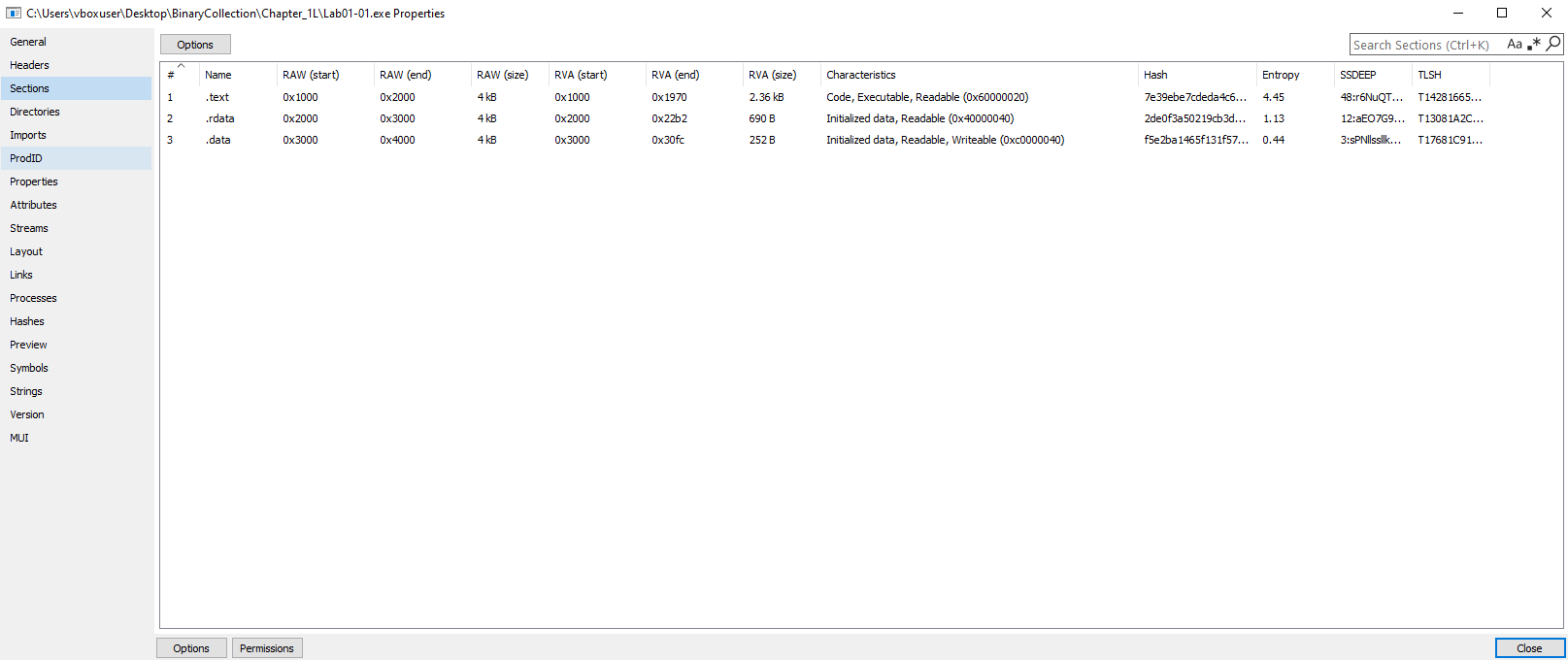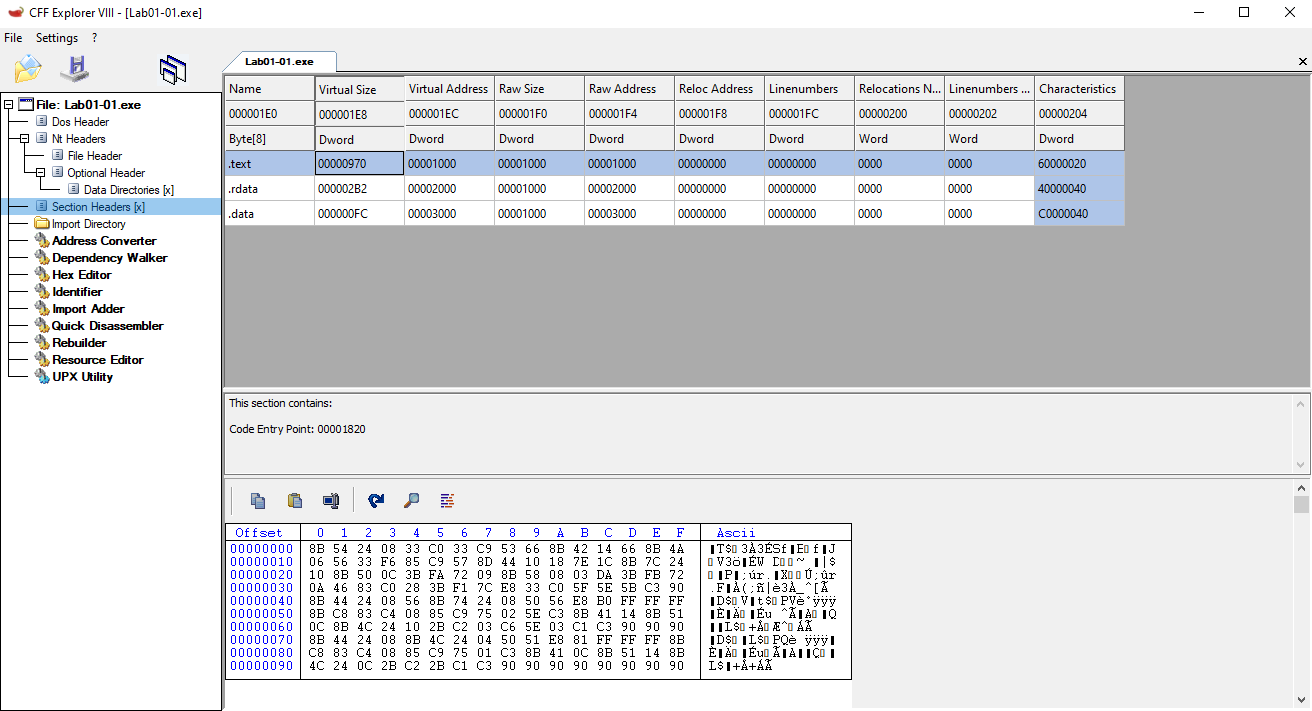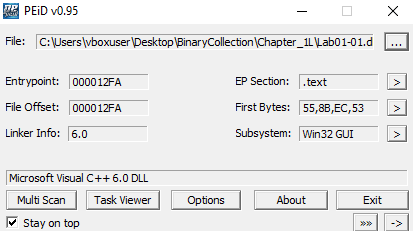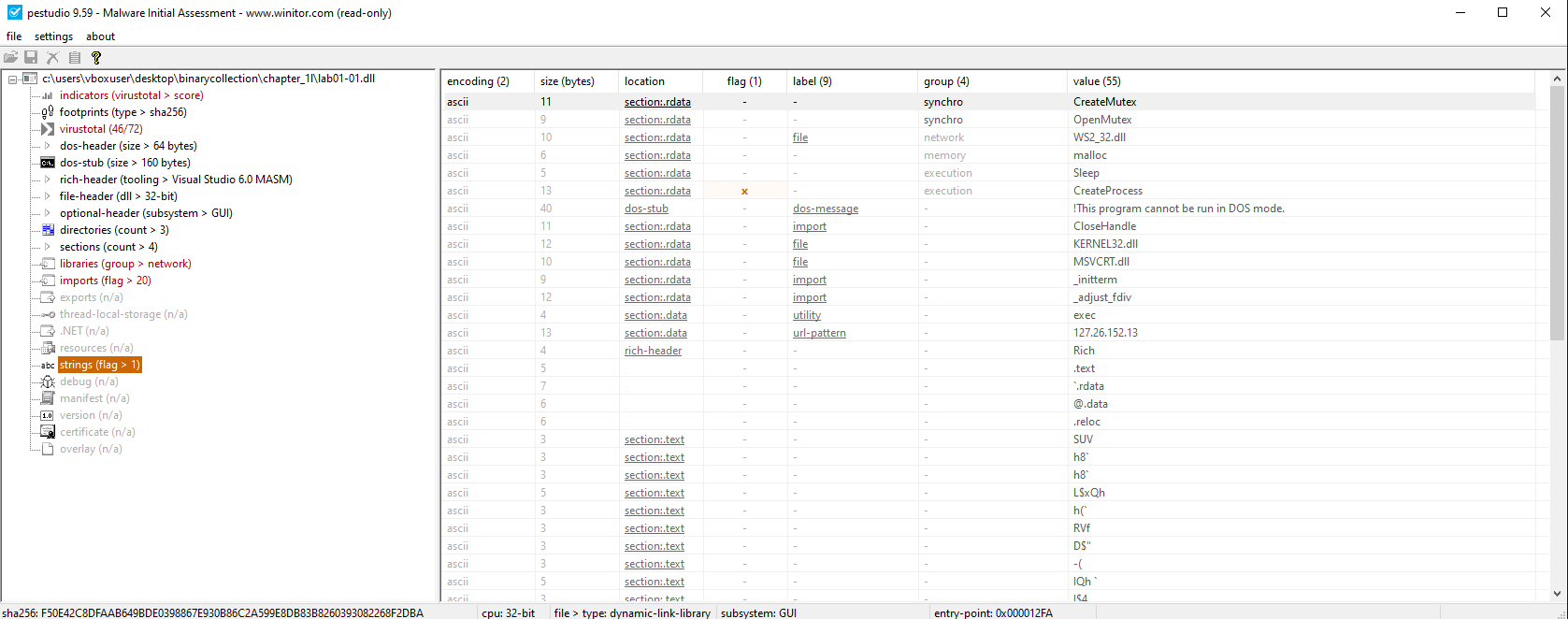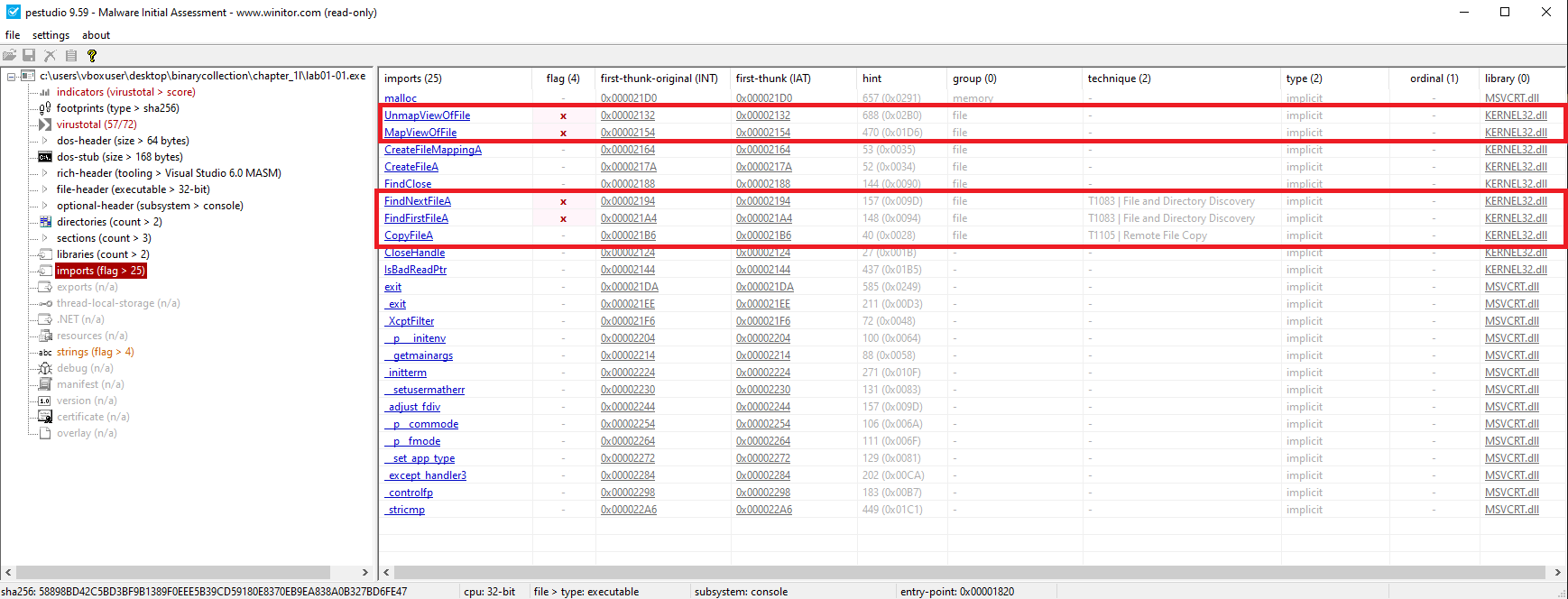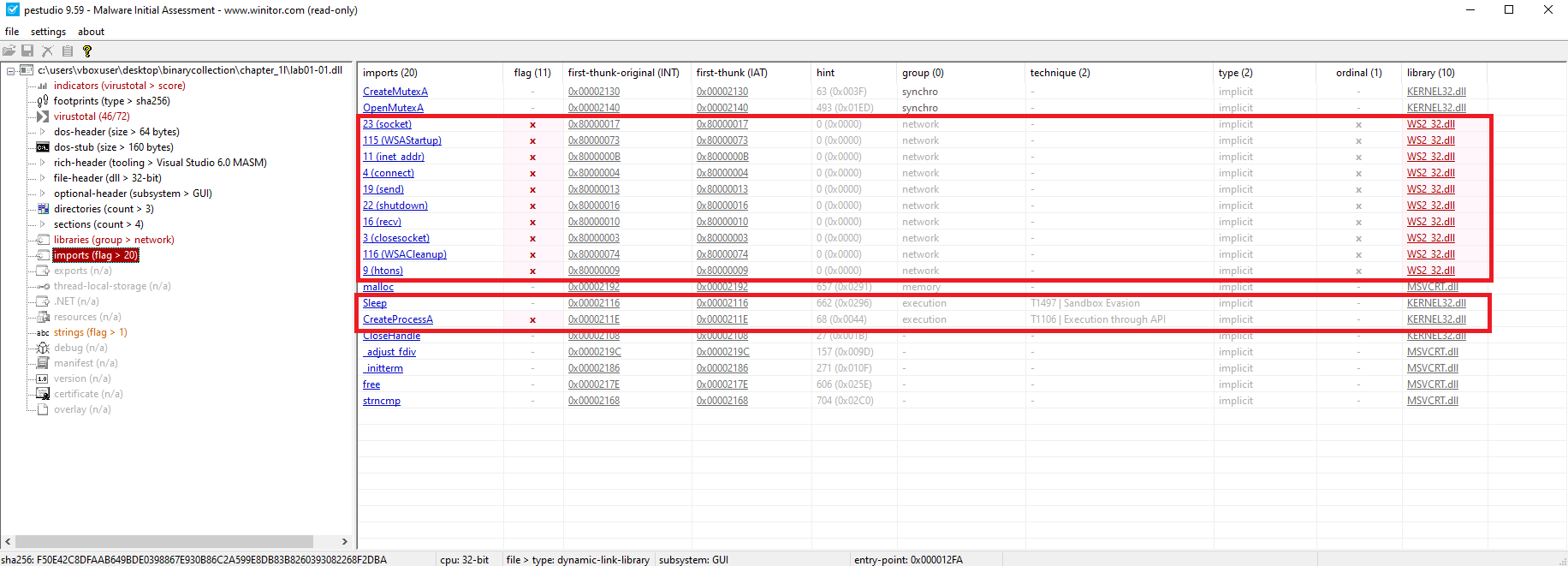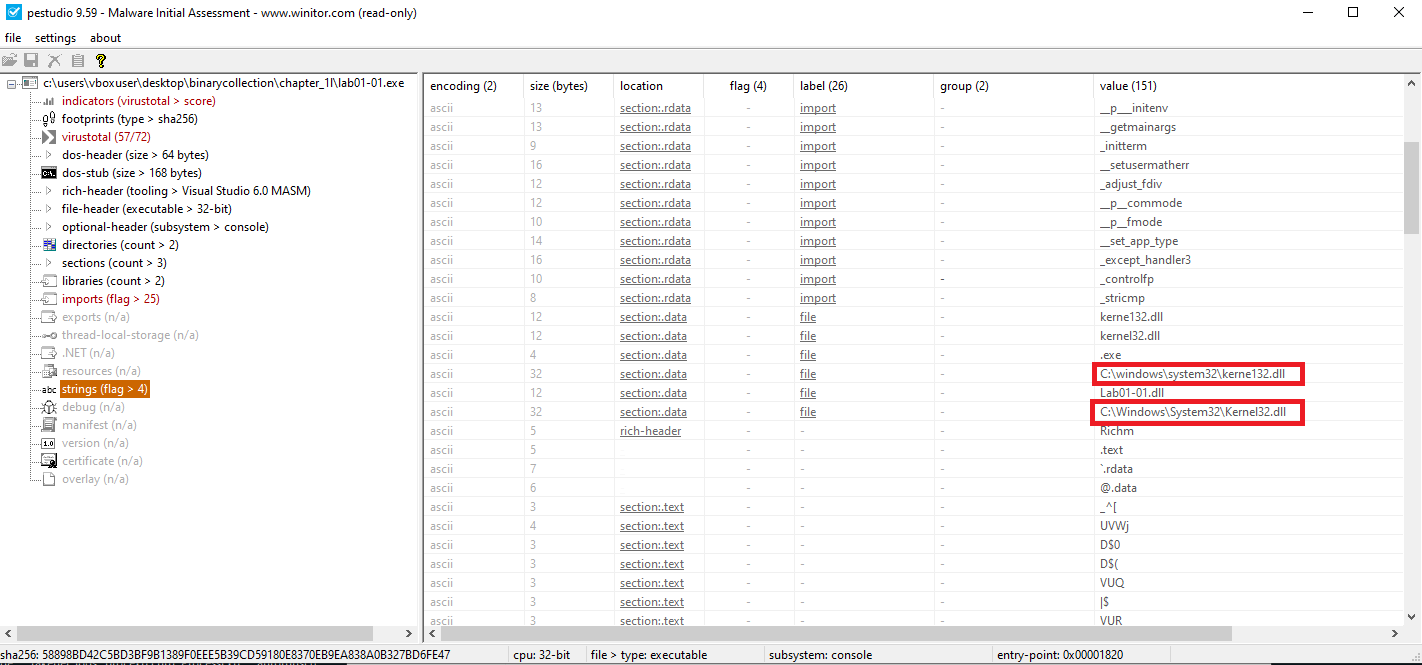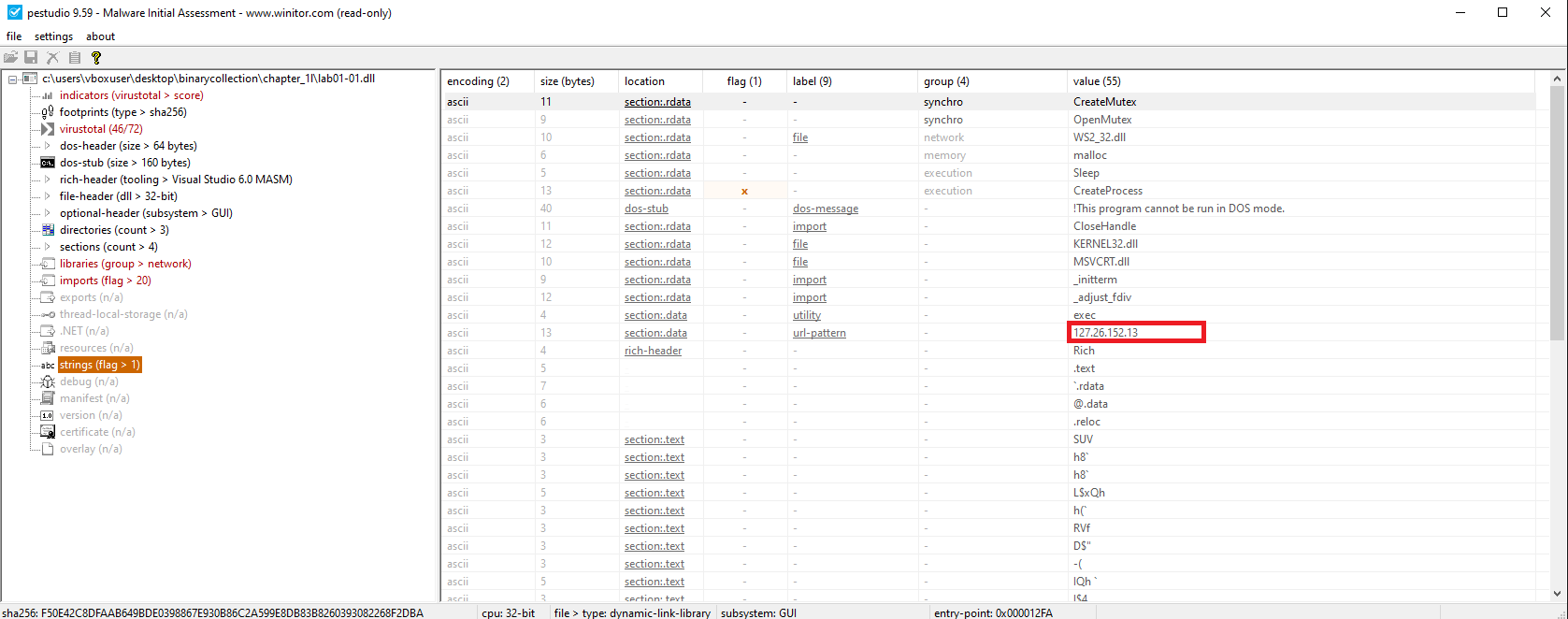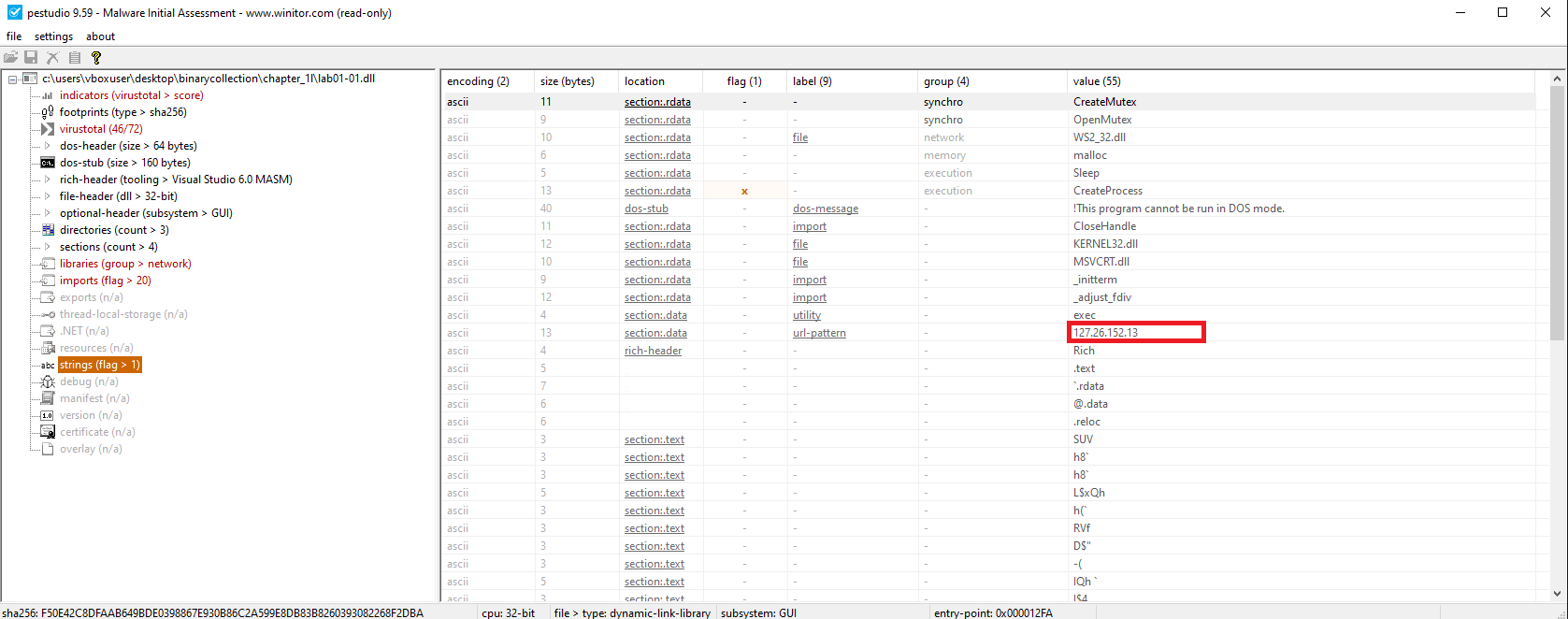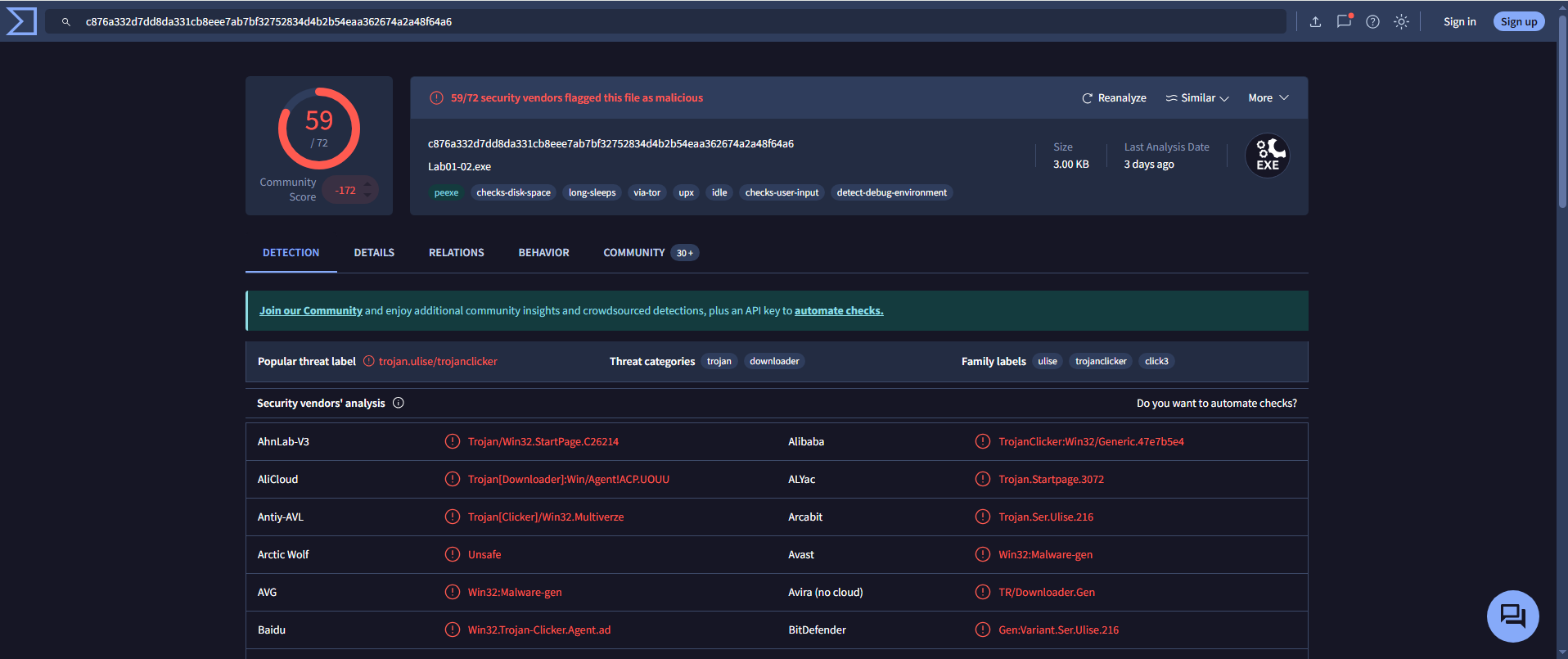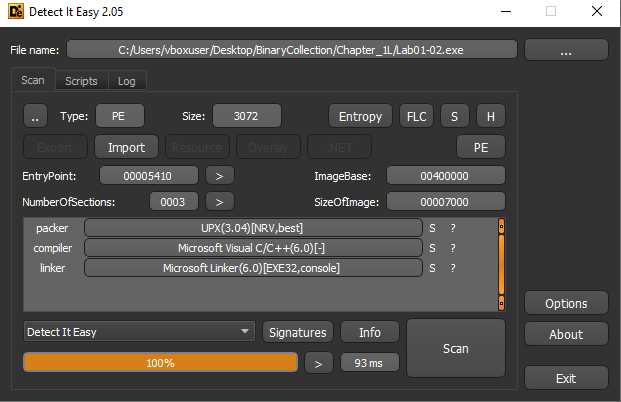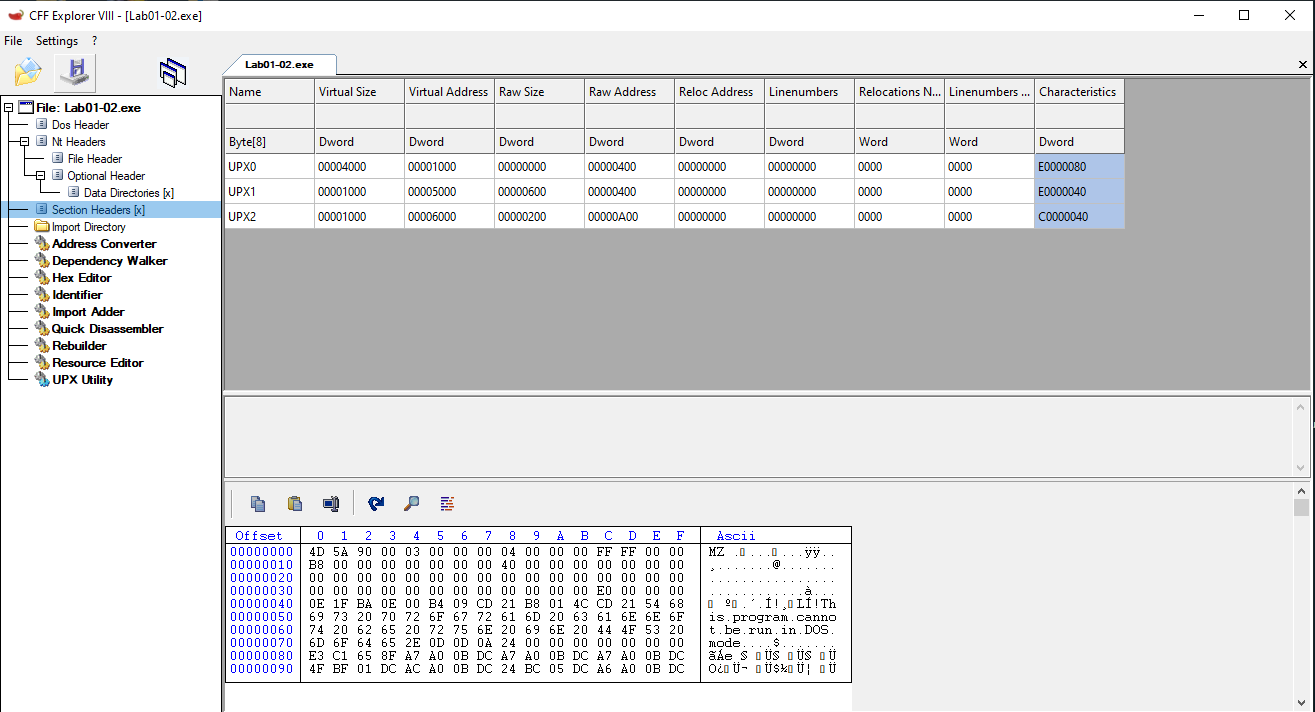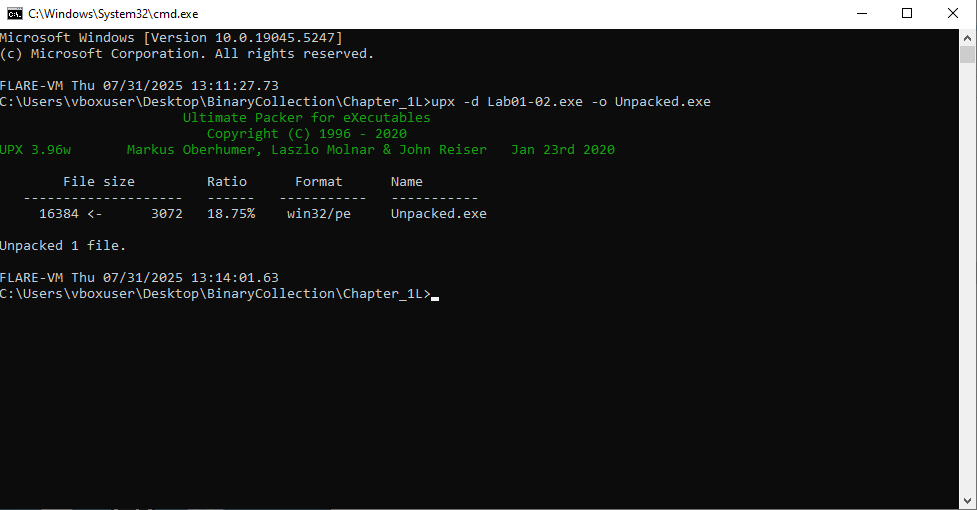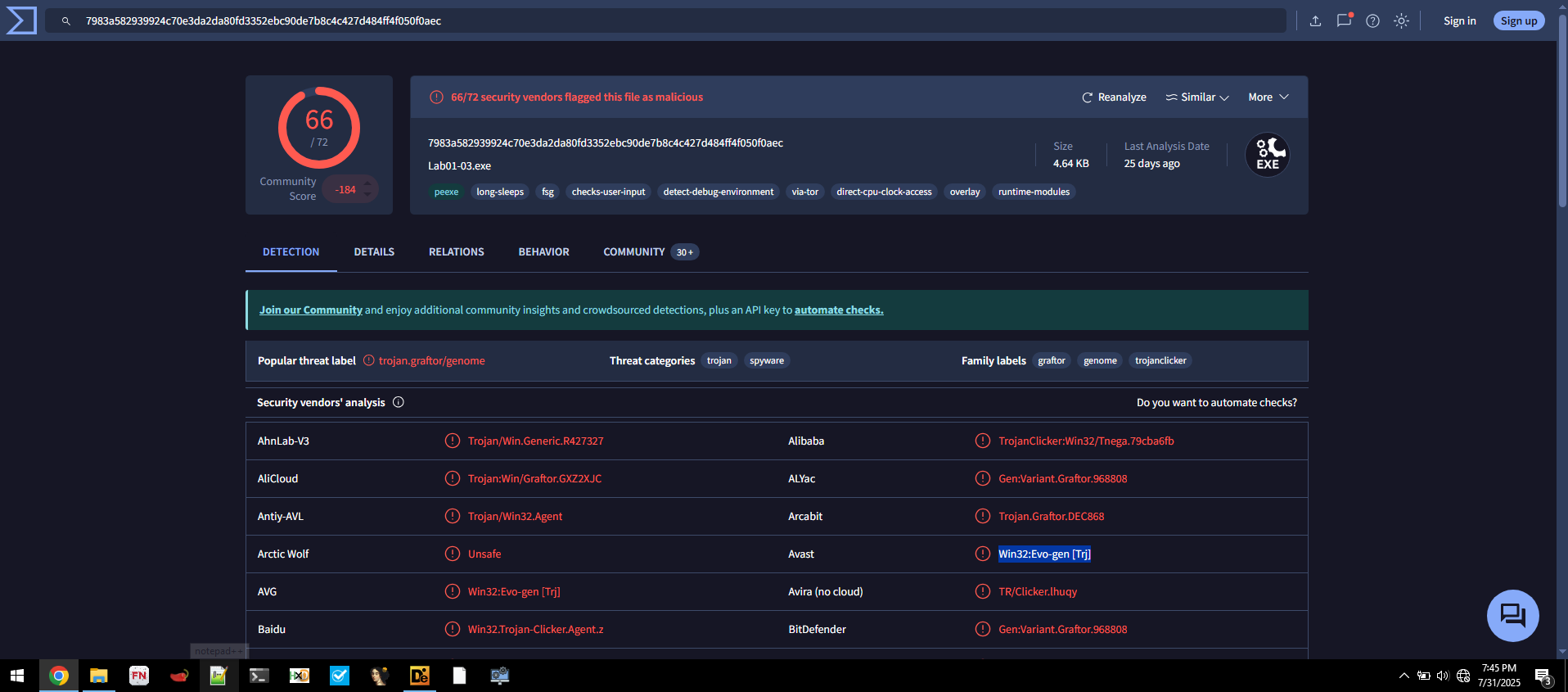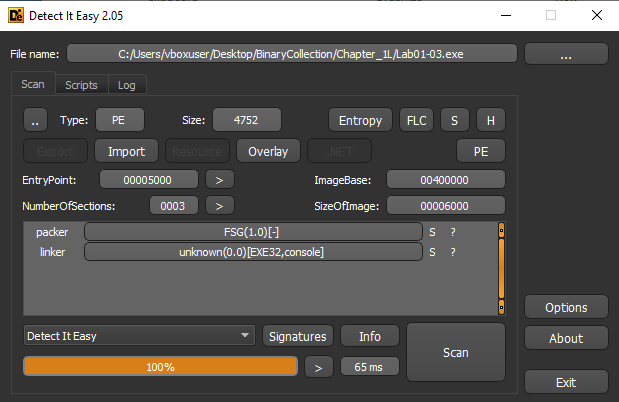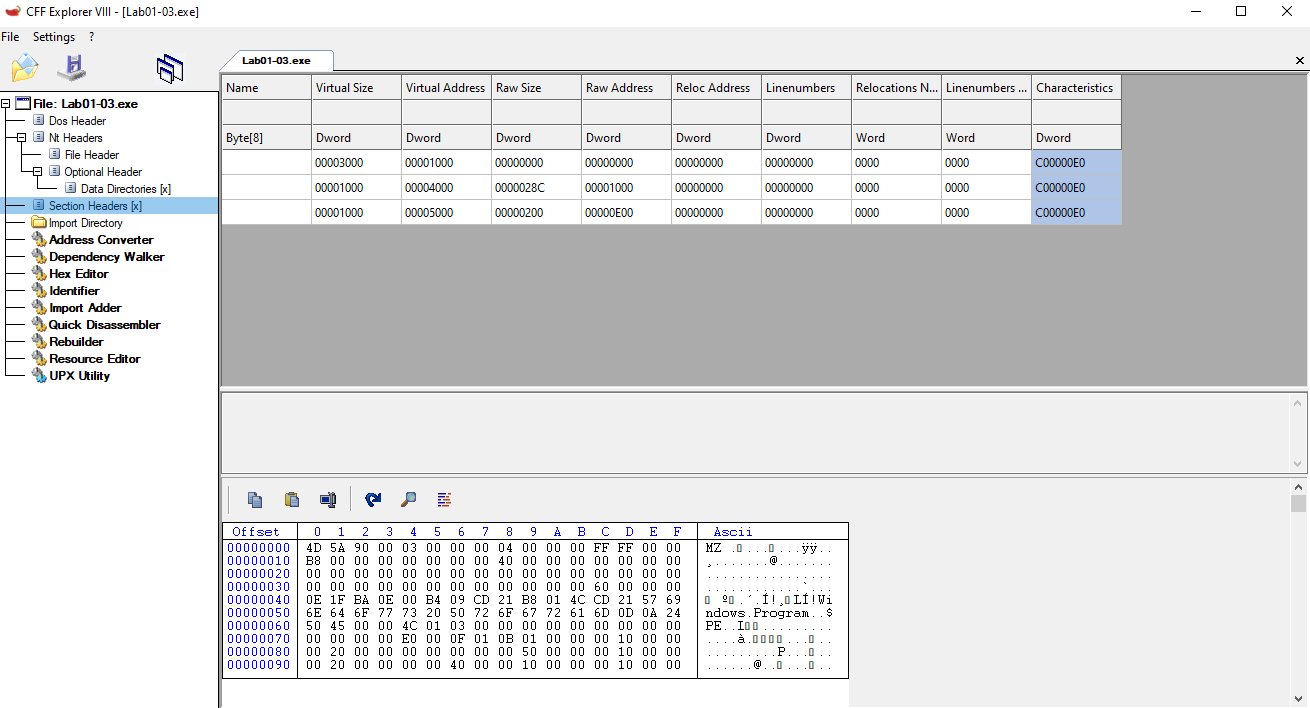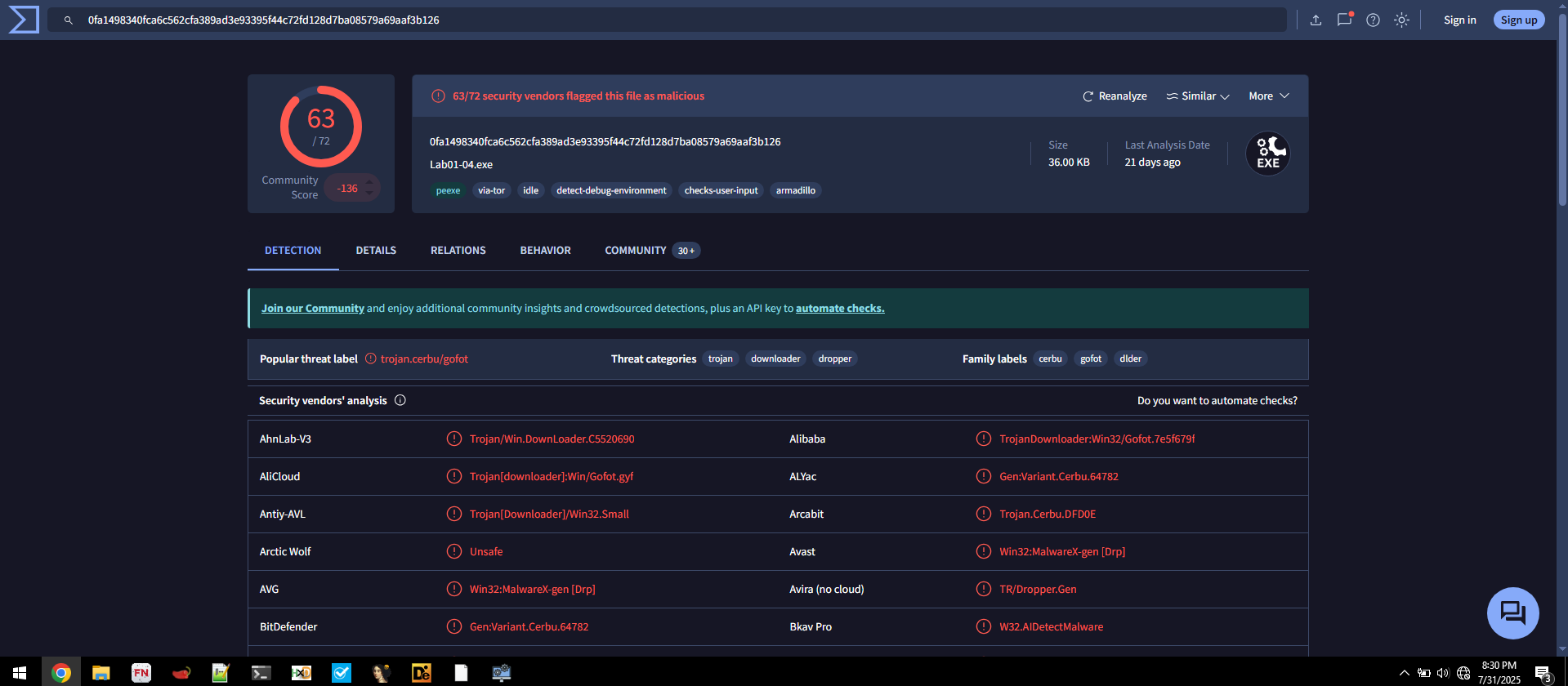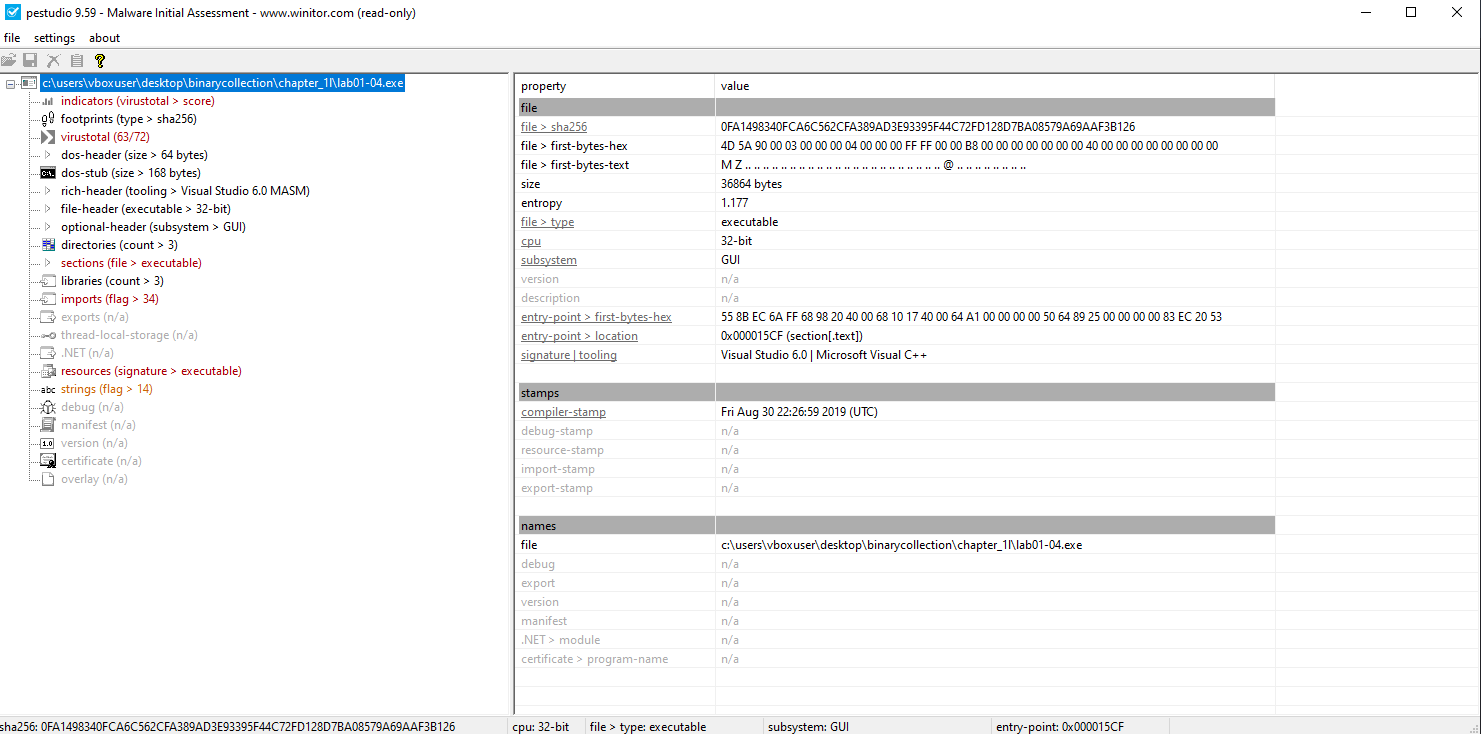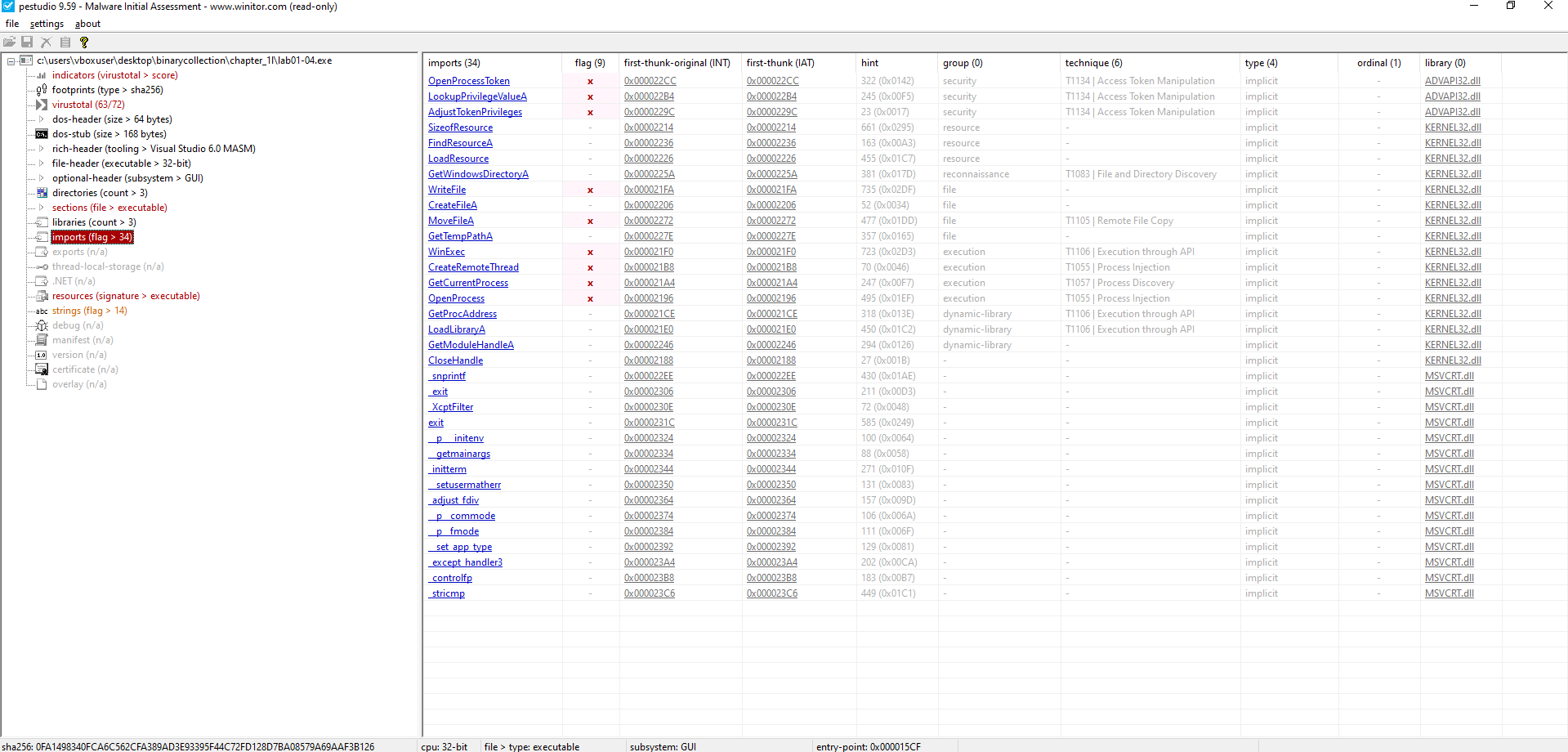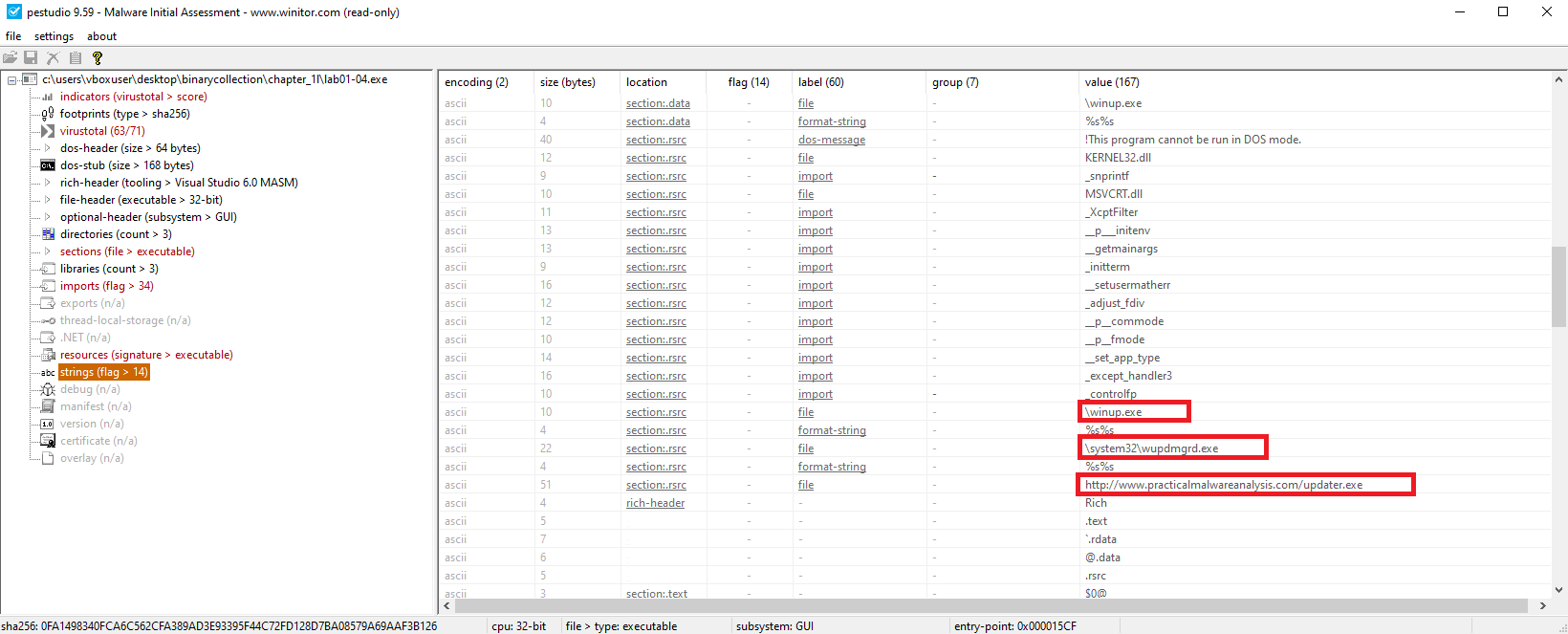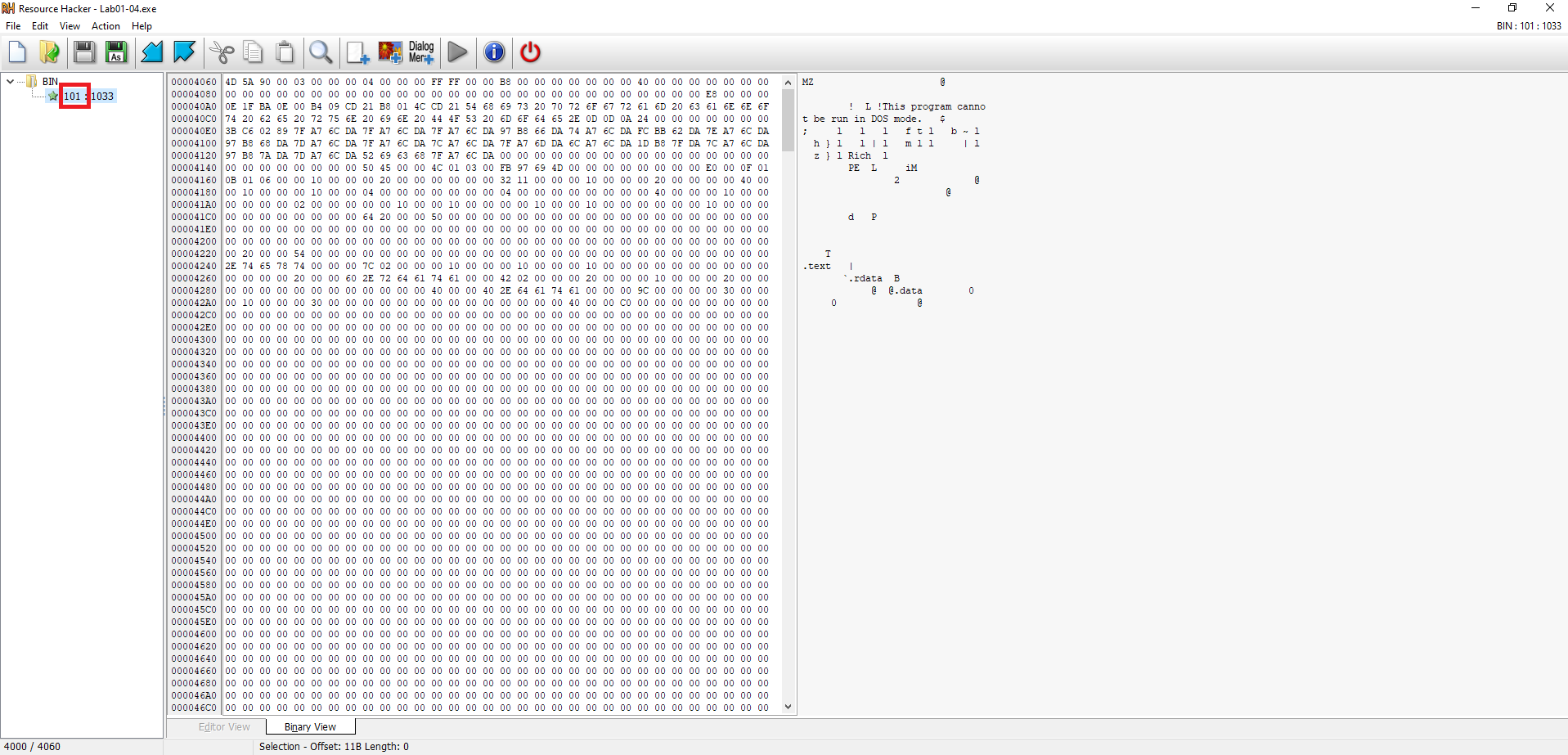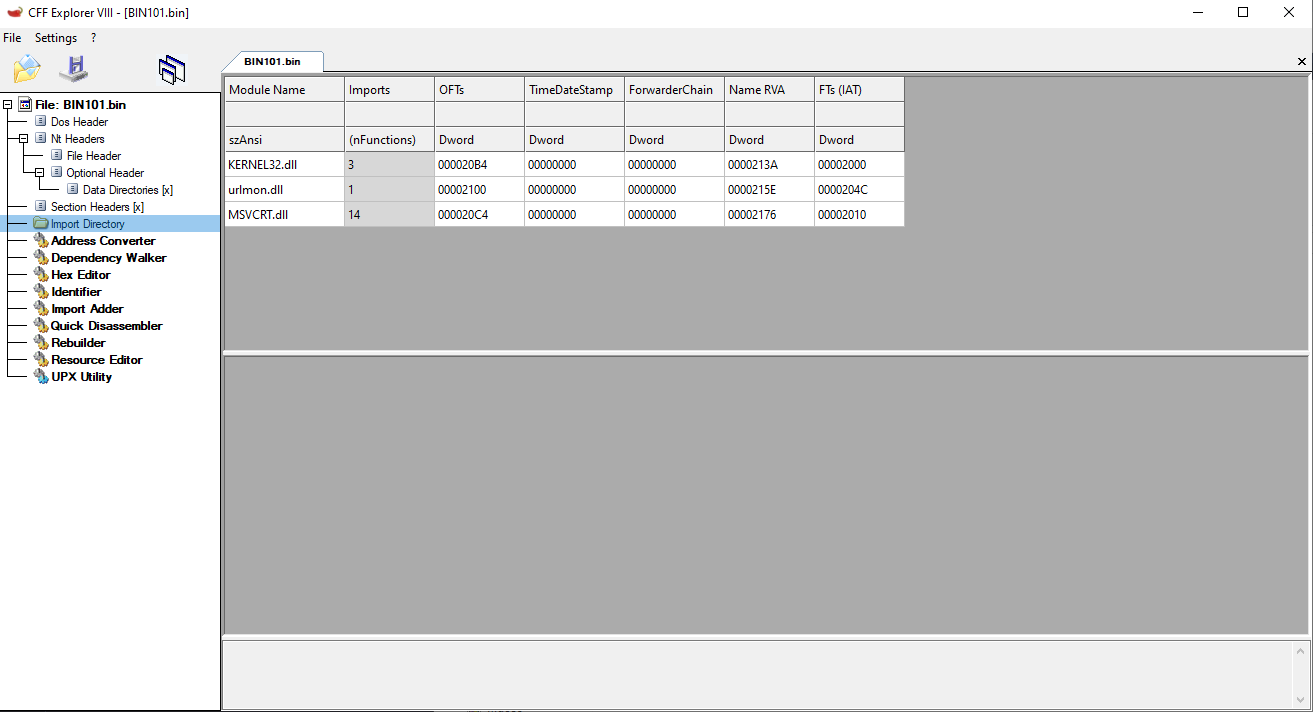PMA Labs
Lab 1-1
📝 Summary
In this lab, we analyze Lab01-01.exe and Lab01-01.dll using static analysis techniques.
Our goal is to identify suspicious characteristics, determine the purpose of the files, and extract any host-based or network-based indicators.
We use tools such as PE Studio, PEiD, PEview, Strings, Dependency Walker, Detect It Easy, and VirusTotal.
📍 Question 1: VirusTotal Detections
Do either files match any existing antivirus signatures?
🟩 Lab01-01.exe
- Detection Ratio:
56 / 71 - Common AV Detections:
CrowdStrike Falcon: Win/malicious_confidence_100%AVG: Win32:MalwareX-gen
🟨 Lab01-01.dll
- Detection Ratio:
46 / 72 - Common AV Detections:
AVG: Win32:Malware-genBitdefender: Gen:Variant.Doina.76618
📍 Question 2: Compilation Timestamps
When were these files compiled?
| File | Compilation Time (UTC) |
|---|---|
Lab01-01.exe | Sun Dec 19 16:16:19 2010 |
Lab01-01.dll | Sun Dec 19 16:16:38 2010 |
📍 Question 3: Packed or Obfuscated?
Are there any indications that either file is packed or obfuscated?
🟩 Lab01-01.exe
- PEiD identifies compiler as Microsoft Visual C++ 6.0
- Strings are clearly visible
- Normal entropy values
- Standard section names like
.text,.data,.rdata - Virtual size ≈ Raw size
🟨 Lab01-01.dll
Same characteristics as above:
Conclusion: There is no indication that these files are packed or obfuscated.
📍 Question 4: Suspicious Imports
Do any imports hint at what this malware does?
🟩 Lab01-01.exe
Key Imports (KERNEL32.DLL):
CopyFileAFindFirstFileA()FindNextFileA()
Indicates file enumeration and manipulation functionality.
🟨 Lab01-01.dll
Key Imports (KERNEL32.DLL):
CreateMutexA()– ensures single instanceCreateProcessA()– spawns new processesSleep()– possible anti-analysis
Key Imports (WS2_32.DLL):
WSAStartup(),socket(),connect()– network communication (C2)
📍 Question 5: Host-Based Indicators
Are there any files or artifacts to look for on infected systems?
🟩 Lab01-01.exe
Possible copied path:
C:\windows\system32\kerne132.dll
🟨 Lab01-01.dll
Hardcoded IP address:
127.26.152.13
📍 Question 6: Network-Based Indicators
What network-based indicators could be used to detect this malware?
🟩 Lab01-01.exe
No observed network indicators
🟨 Lab01-01.dll
Connects to:
127.26.152.13
📍 Question 7: Purpose of the Files
What is the suspected purpose of these files?
🟩 Lab01-01.exe
Its purpose is to deploy and execute the malicious DLL on the system, potentially copying it to the System32 directory for persistence.
🟨 Lab01-01.dll
Its purpose is to function as a backdoor or Remote Access Trojan (RAT) — enabling file system access and communication with a C2 server.
Lab 1-2
📝 Summary
In this lab, we analyze Lab01-02.exe using static analysis techniques. Our goal is to identify suspicious characteristics, understand the program’s functionality, and extract any host-based or network-based indicators of compromise (IOCs).
📍 Question 1: VirusTotal Detections
🟥 Lab01-02.exe
Does Lab01-02.exe match any known antivirus signatures?
- Detection Ratio:
59 / 72 - Common AV Detections:
Avast: Win32:Malware-genAVG: Win32:Malware-gen
📍 Question 2: Packed or Obfuscated?
🟥 Lab01-02.exe
Are there any indications that this file is packed or obfuscated? If so, what are these indicators? If the file is packed, unpack it if possible.
- Packing Detected:
Using Detect It Easy, the file is identified as packed with UPX (Ultimate Packer for eXecutables).
- Supporting Indicators:
- Sections named UPX0 and UPX1
- A large difference between Virtual Size and Raw Size
- Very limited imported functions (typical of UPX-packed binaries)
- No visible readable strings in the initial state
1
2
# Unpack Lab with UPX
upx -d Lab01-02.exe -o Unpacked.exe
📍 Question 3: Suspicious Imports
🟥 Lab01-02.exe
Do any imports hint at this program’s functionality? If so, which imports are they and what do they tell you? 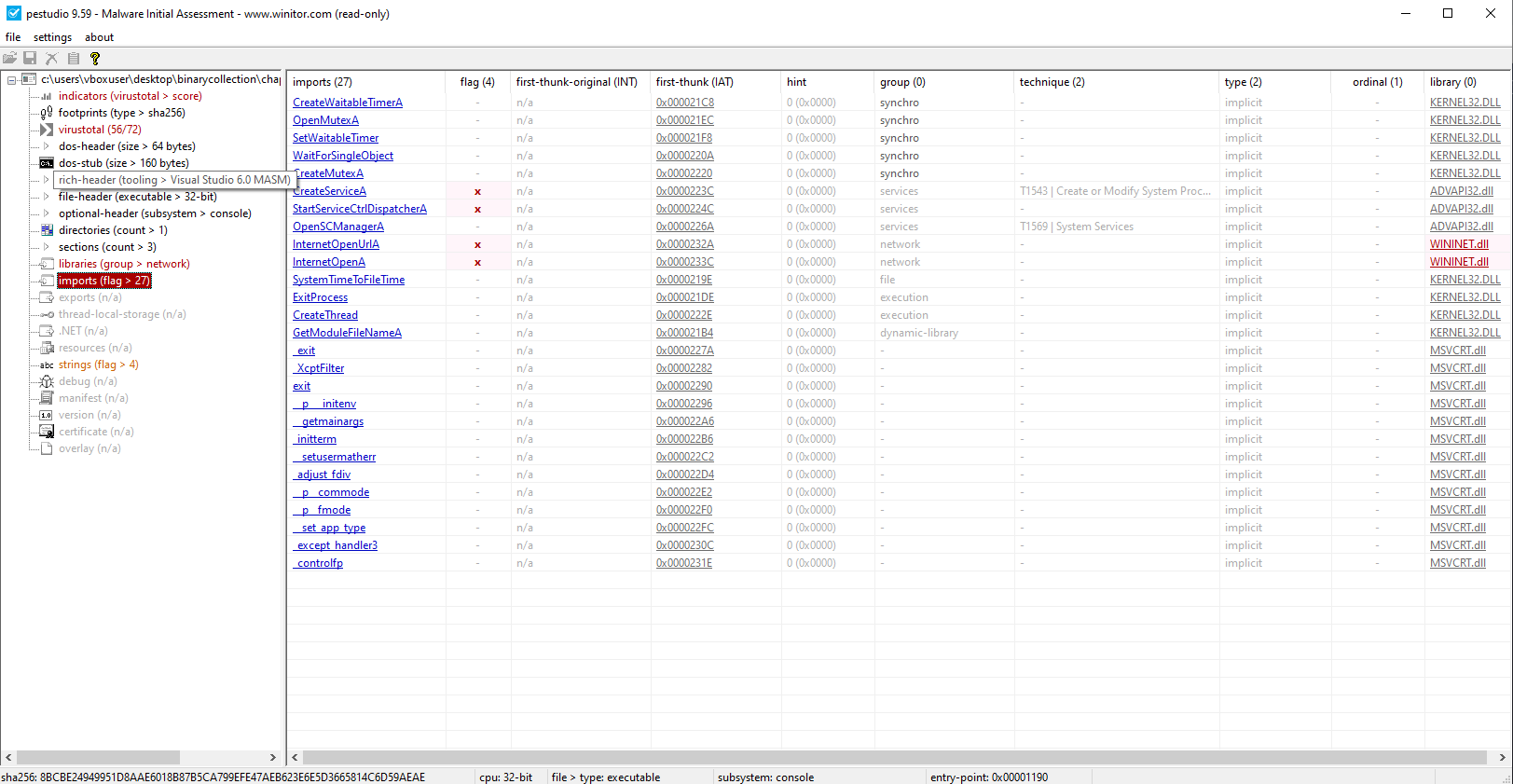
Key Imports (WININET.DLL):
InternetOpen()InternetOpenUrl()
These functions suggest the program may perform network communications, such as retrieving data from the internet, downloading additional payloads, or connecting to a command-and-control (C2) server.
Key Imports (ADVAPI32.DLL):
OpenSCManager()CreateService()StartServiceCtrlDispatcher()
These indicate functionality to create and manage Windows services, a common persistence mechanism that allows the malware to automatically run at system startup under elevated privileges.
📍 Question 4: Network-Based Indicators
🟥 Lab01-02.exe
What host- or network-based indicators could be used to identify this malware on infected machines? 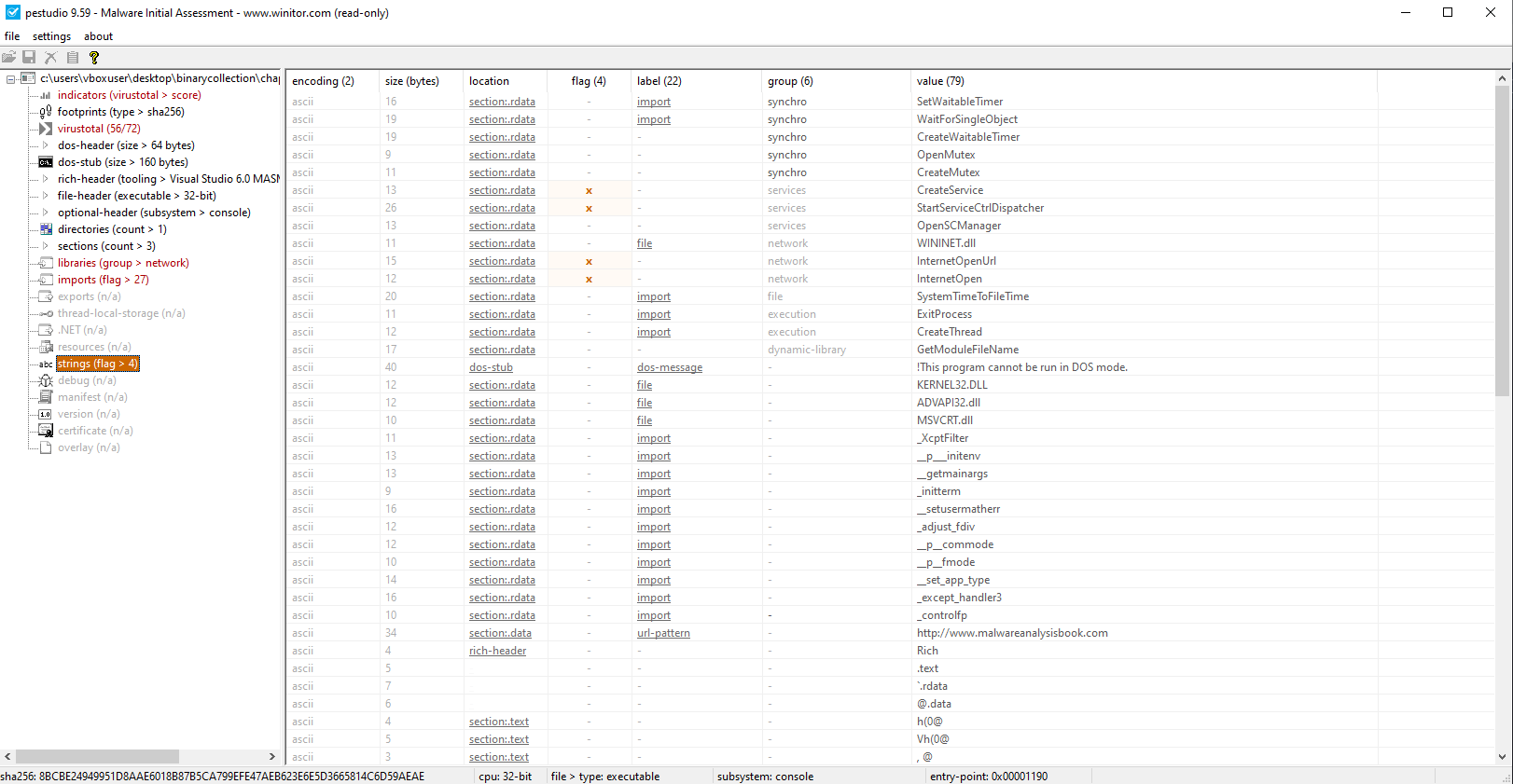
Connects to:
http://www.malwareanalysisbook.com
Lab 1-3
📝 Summary
In this lab, we analyze Lab01-03.exe using static analysis techniques. Our goal is to identify suspicious characteristics, understand the program’s functionality, and extract any host-based or network-based indicators of compromise (IOCs).
📍 Question 1: VirusTotal Detections
🟦 Lab01-03.exe
Does Lab01-03.exe match any known antivirus signatures?
- Detection Ratio:
66 / 72 - Common AV Detections:
Avast: Win32:Evo-gen [Trj]AVG: Win32:Evo-gen [Trj]
📍 Question 2: Packed or Obfuscated?
🟦 Lab01-03.exe
Are there any indications that this file is packed or obfuscated? If so, what are these indicators? If the file is packed, unpack it if possible.
- Packing Detected:
Using Detect It Easy, the file is identified as packed with FSG (Fast Small Good) packer.
- Supporting Indicators:
- Sections unnamed
- A large difference between Virtual Size and Raw Size
- Very limited imported functions (typical of FSG-packed binaries)
- No visible readable strings in the initial state
we can’t unpack this file
📍 Question 3: Suspicious Imports
🟦 Lab01-03.exe
Do any imports hint at this program’s functionality? If so, which imports are they and what do they tell you?
⚠️ Note: To fully analyze suspicious imports, the file must be unpacked.
With the techniques learned so far, we are unable to unpack FSG.
📍 Question 4: Network-Based Indicators
🟦 Lab01-03.exe
What host- or network-based indicators could be used to identify this malware on infected machines?
Lab 1-4
📝 Summary
In this lab, we analyze Lab01-04.exe using static analysis techniques. Our goal is to determine whether the file is packed or obfuscated, identify its compilation details, and examine its imports to understand the program’s potential functionality. We also aim to extract host-based and network-based indicators of compromise (IOCs) and inspect the resource section for any hidden or embedded components.
📍 Question 1: VirusTotal Detections
🟪 Lab01-04.exe
Does Lab01-04.exe match any known antivirus signatures?
- Detection Ratio:
63 / 72 - Common AV Detections:
Avira: TR/Dropper.GenAVG: Win32:MalwareX-gen [Drp]
📍 Question 2: Packed or Obfuscated?
🟪 Lab01-04.exe
Are there any indications that this file is packed or obfuscated? If so, what are these indicators? If the file is packed, unpack it if possible.
Not Packed
📍 Question 3: compilation date?
🟪 Lab01-04.exe
When was this program compiled?
| File | Compilation Time (UTC) |
|---|---|
Lab01-01.exe | Fri Aug 30 22:26:59 2019 |
📍 Question 4: Suspicious Imports
🟪 Lab01-04.exe
Do any imports hint at this program’s functionality? If so, which imports are they and what do they tell you?
Key Imports (ADVAPI32.DLL):
OpenProcessTokenLookupPrivilegeValueAAdjustTokenPrivileges
Indicates access token manipulation for privilege escalation, possibly enabling
SeDebugPrivilegeto interact with other processes.
Key Imports (KERNEL32.DLL):
CreateFileAWriteFileMoveFileAGetTempPathA
Suggests file manipulation capabilities such as creating, writing, moving files, and using temporary paths—often used for staging malicious payloads.
Key Imports (KERNEL32.DLL):
WinExecCreateRemoteThreadOpenProcess
Points to possible code execution and process injection into other running processes.
Key Imports (KERNEL32.DLL):
LoadLibraryAGetProcAddressGetModuleHandleA
Enables dynamic loading and resolution of APIs or DLLs—commonly used to evade static detection and load payloads at runtime.
📍 Question 5: Network-Based Indicators
🟪 Lab01-04.exe
What host-based or network-based indicators could be used to identify this malware on infected machines?
Network-Based Indicators:
- Hardcoded URL:
http://www.malwareanalysisbook.com/updater.exeSuggests the malware attempts to download additional payloads or check in for updates. This is a high-fidelity indicator for network detection.
- Domain:
www.malwareanalysisbook.com
Host-Based Indicators:
- Host-based:
\system32\wupdmgrd.exe\winup.exe
📍 Question 6: Resources
🟪 Lab01-04.exe
This file has one resource in the resource section. Use Resource Hacker to examine that resource, and then use it to extract the resource. What can you learn from the resource? Steps Performed:
- Opened the sample in Resource Hacker
- Navigated to
.rsrc→RCDATA→101→1033. - Observed that the resource’s binary data begins with
4D 5A(MZ header), confirming it is an embedded executable.
- Navigated to
- Extracted the resource
- Right-clicked
1033→ Save Resource to a bin file → saved it asbin101.bin.
- Right-clicked
- Inspected the extracted file in CFF Explorer
- Loaded
bin101.binin CFF Explorer and checked the Import Directory. - Found these key imports:
KERNEL32.DLLURLMON.DLL → URLDownloadToFileA
- Loaded

